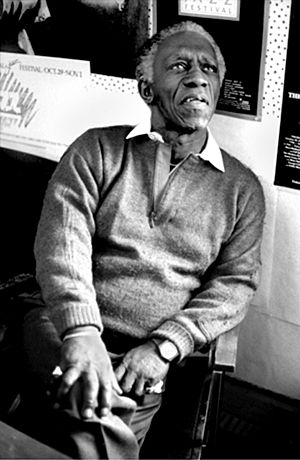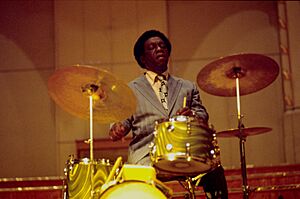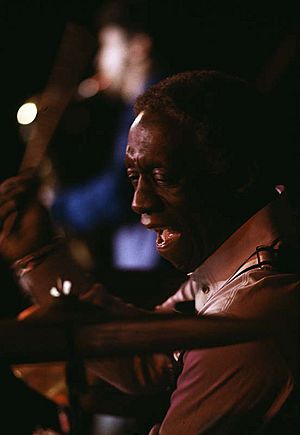Art Blakey facts for kids
Quick facts for kids
Art Blakey
|
|
|---|---|

Blakey in 1982 during a radio interview at KJAZ
|
|
| Background information | |
| Birth name | Arthur Blakey |
| Also known as | Abdullah Ibn Buhaina |
| Born | October 11, 1919 Pittsburgh, Pennsylvania, U.S. |
| Died | October 16, 1990 (aged 71) New York City, U.S. |
| Genres | |
| Occupation(s) |
|
| Instruments |
|
| Years active | 1942–1990 |
| Labels | Blue Note |
| Associated acts | |
Arthur Blakey (born October 11, 1919 – died October 16, 1990) was a famous American jazz drummer and bandleader. He was also known as Abdullah Ibn Buhaina for a short time after he became a Muslim in the late 1940s.
Blakey became well-known in the 1940s playing in big bands led by Fletcher Henderson and Billy Eckstine. He then worked with important bebop musicians like Thelonious Monk, Charlie Parker, and Dizzy Gillespie. In the mid-1950s, Blakey and Horace Silver started a group called the Jazz Messengers. Blakey led this group for the next 35 years.
The Jazz Messengers became famous for helping young, talented musicians get their start. Many future jazz stars, such as Freddie Hubbard, Wayne Shorter, and Wynton Marsalis, played in the band. People often called the Jazz Messengers the best example of a "hard bop" jazz group from the late 1950s.
Art Blakey was honored many times for his music. He was inducted into the Down Beat Jazz Hall of Fame in 1981. After he passed away, he was also added to the Modern Drummer Hall of Fame in 1991 and the Grammy Hall of Fame in 1998 and 2001. He received the Grammy Lifetime Achievement Award in 2005.
Contents
Early Life and Music Journey
Art Blakey was born in Pittsburgh, Pennsylvania, on October 11, 1919. He was raised by a family friend, Annie Parran, and her husband.
Blakey learned to play the piano in school and also taught himself. By the time he was in seventh grade, he was playing music full-time to earn money. He also started learning how to lead a band.
At some point in the early 1930s, Blakey switched from playing the piano to playing the drums. He developed an energetic drumming style, similar to other great drummers like Chick Webb.
Career Highlights
From 1939 to 1944, Blakey played with Mary Lou Williams and toured with the Fletcher Henderson Orchestra. During his time with Henderson's band, Blakey was injured in an attack, which meant he could not serve in World War II.
From 1944 to 1947, Blakey played with Billy Eckstine's big band. This group helped him become part of the new bebop jazz movement. He played alongside other rising stars like Miles Davis, Dizzy Gillespie, and Charlie Parker.
After the Eckstine band broke up, Blakey traveled to Africa. He spent two years there, learning about the culture and especially about drums. During this time, he also studied and became a Muslim, taking the name Abdullah Ibn Buhaina. Even though he later stopped practicing Islam, he continued to perform as "Art Blakey."
In the early 1950s, Blakey played drums for many famous musicians, including Miles Davis, Charlie Parker, and Thelonious Monk. Many people thought he was Monk's best drummer. He played on Monk's very first recording session in 1947 and his last one in 1971.
The Jazz Messengers

In 1947, Art Blakey led his first recording session as a bandleader with a group called "Art Blakey's Messengers." This was the start of what would become his most famous band.
The name "Jazz Messengers" was first used in 1954 for a group co-led by Blakey and pianist Horace Silver. When Silver left the band a year later, Blakey took over completely. The group then became known as "Art Blakey and the Jazz Messengers." Blakey led this band for the rest of his life.
The Jazz Messengers became the most important "hard bop" jazz group of the 1950s. They played a powerful and energetic style of jazz that had strong blues roots. The band was always changing, with new young musicians joining all the time. Being a part of the Jazz Messengers was a big step for many young jazz artists.
Many famous jazz musicians got their start with the Jazz Messengers. These include Lee Morgan, Wayne Shorter, Freddie Hubbard, Bobby Timmons, and Wynton Marsalis. The band helped shape the careers of several generations of jazz stars.

Some of the band's musical directors, like Benny Golson, wrote famous jazz songs that the band played. These included "I Remember Clifford" and "Blues March."
Later Career
Art Blakey continued to record many albums with the Jazz Messengers, always bringing in new, young musicians. He believed in giving young talent a chance. He once said, "I'm gonna stay with the youngsters. When these get too old I'll get some younger ones. Keeps the mind active."
Even when jazz styles changed in the 1970s, Blakey's band kept playing. He continued to perform and tour with the group until the end of the 1980s. Blakey was known for playing with great power. Towards the end of his life, he had some hearing loss, but he still played by feeling the vibrations of the music.
Art Blakey's last performances were in July 1990. He passed away on October 16, 1990, from lung cancer, just five days after his 71st birthday.
Music Style
Drumming Style
Art Blakey is known as one of the inventors of the modern bebop style of drumming, along with Kenny Clarke and Max Roach. Max Roach, another great drummer, once said that Blakey was unique and that his drumming style was amazing. He called Blakey "Thunder" because of his powerful playing.
Blakey was very skilled at playing different rhythms with all four of his limbs at the same time. He created a deep cymbal sound and often used loud accents on his snare and bass drums. After his trip to Africa, he started using some African drumming techniques, like tapping on the side of the drum and using his elbow on the tom-tom to change its sound.
One of his signature moves, which many drummers copied, was forcefully closing the hi-hat cymbal on the second and fourth beats of the music. Blakey was a loud and strong drummer, but he also listened carefully and responded to the musicians playing solos.
Legacy
Art Blakey and his bands left behind not only amazing music but also a lasting impact on jazz musicians. The Jazz Messengers helped train and inspire many important jazz artists. They played a key role in the "hard bop" movement of the late 1950s and early 1960s, and also influenced the "Neotraditionalist" jazz of the 1980s and 1990s.
As drummer Cindy Blackman said after Blakey's death, "When jazz was in danger of dying out [in the 1970s], there was still a scene. Art kept it going." Blakey's dedication helped keep jazz alive and thriving.
Personal Life
Besides music, Art Blakey was a great storyteller. He also had a big love for food and was interested in boxing.
Blakey had ten children: daughters Gwendolyn, Evelyn, Jackie, Kadijah, Sakeena, and Akira, and sons Art Jr., Takashi, Kenji, and Gamal.
Awards
- Down Beat Jazz Hall of Fame Reader's Choice Award (1981)
- Jazz Hall of Fame Induction (1982)
- Grammy Award Best Jazz Instrumental Performance, Group, for the album New York Scene (1984)
- Grammy Hall of Fame Induction for the single "Moanin'" (1998)
- Grammy Hall of Fame Induction for the album Moanin (2001)
- Grammy Lifetime Achievement Award (2005; awarded after his death)
Discography
- Albums where Blakey was the main leader or played solo are shown in bold.
- The album date is based on when it was recorded, not when it was released.
- New Sounds (1952)
- A Night at Birdland Vol. 1 (1954)
- A Night at Birdland Vol. 2 (1954)
- A Night at Birdland Vol. 3 (1954)
- Blakey (1954)
- At the Cafe Bohemia, Vol. 1 (1955)
- At the Cafe Bohemia, Vol. 2 (1955)
- The Jazz Messengers (1956)
- Originally (1956)
- Hard Bop (1956)
- Ritual (1957)
- Drum Suite (1957)
- ... in Rhythm (1957)
- A Midnight Session (1957)
- Selections from Lerner and Loewe's... (1957)
- Cu-Bop (1957)
- With Thelonious Monk (1957)
- Hard Drive (1957)
- Big Band (1957)
- Moanin' (1958)
- Drums Around the Corner (1958)
- Holiday for Skins (1958)
- 1958 – Paris Olympia (1958)
- Des Femmes Disparaissent (1958)
- The St. Germain Club (1958)
- At the Jazz Corner of the World (1959)
- Les Liaisons Dangereuses (1959)
- Africaine (1959)
- The Théâtre des Champs-Élysées (1959)
- Paris Jam Session (1959)
- The Big Beat (1960)
- A Night in Tunisia (1961)
- Art Blakey and the Jazz Messengers (1961)
See also
 In Spanish: Art Blakey para niños
In Spanish: Art Blakey para niños

